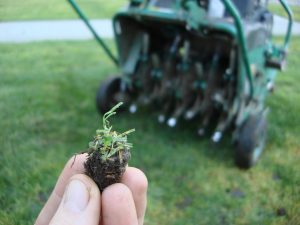LAWN AERATION & THATCHING TIPS
Allows for air, water, and nutrients to get directly to the root zone for a healthier, more resilient turf. Breaks up soil compaction.
Commonly this is done in Spring or Fall.
PLEASE NOTE: "As we are not providing Lawn aeration, Overseeding or Thatching services at this time..." We feel it is still important to provide you with this useful information.

Image Copyright: Horticulture
What will aeration do for my lawn?
As lawns age or sustain heavy use from play, sports activities, pets, vehicle traffic and parking, soil compaction can result. Soil compacting forces are most severe in poorly drained or wet sites. Compaction greatly reduces the pore space within the soil that would normally hold air. Roots require oxygen to grow and absorb nutrients and water. Compaction reduces total pore space and the amount of air within the soil. It has a negative impact on nutrient uptake and water infiltration, in addition to being a physical barrier to root growth. This results in poor top growth and lawn deterioration.
Core aeration can benefit your lawn by:
- Increasing the activity of soil microorganisms that decompose thatch.
- Increasing water, nutrient and oxygen movement into the soil.
- Improving rooting.
- Enhancing infiltration of rainfall or irrigation.
- Helping prevent fertilizer and pesticide run-off from overly compacted areas.
How do I know if I need to aerate?
If in doubt about aeration, remove a square foot section of lawn at least 6 inches deep. If grass roots extend only into the first 1-2 inches, your soil may be compacted and could benefit from core aeration. Expect a seasonal effect with cool-season grass roots being shortest in late summer and at their greatest depth in late spring.
Other reasons to aerate include:
Your lawn is heavily used or driven upon on a regular basis, causing the turf to thin or look unthrifty.
The thatch layer is in excess of 1/2 inch, or You have a heavy clay soil.
Is there any reason not to aerate?
A lawn that is not exposed to soil compacting events will likely grow well and may not need aerification. Winter freezing and thawing cycles and earthworm activity can help loosen slightly compacted soils. If the lawn has a thatch layer in excess of 1/2 inch, then core cultivation can be used as a preventative approach to control excess thatch build up. Newly seeded or sodded lawns should not be aerated in the first year.
What else do I need to know?
Aeration helps to control thatch.
It is extremely difficult to core aerate heavy clay soils or soils that have stones, rocks or tree roots below the soil surface.
Be sure to mark sprinkler heads, shallow lines from sprinkler, underground utilities, cable, and septic lines before aerating so they will not be damaged.
Soil cores are best left on the lawn surface; they typically work back into the grass in 2-4 weeks.
Lawns may be fertilized and seeded immediately following aeration with or without further soil top dressing.
If your soil is heavily compacted, you can apply stable, mature compost 1/4 inch deep. Rake the compost over the lawn, filling the aeration holes.
Lawns can be aerated once a year, especially under heavy use conditions
